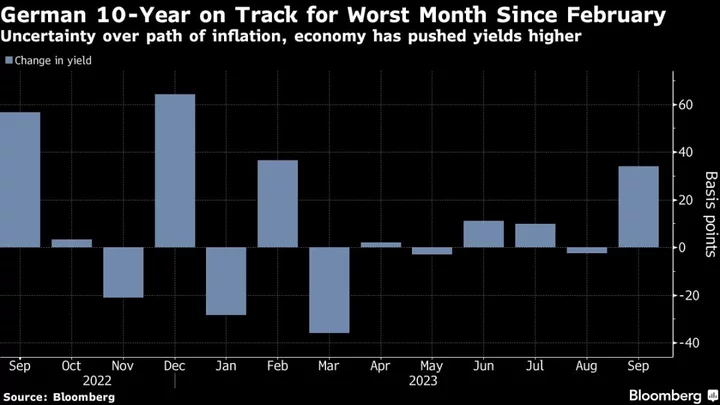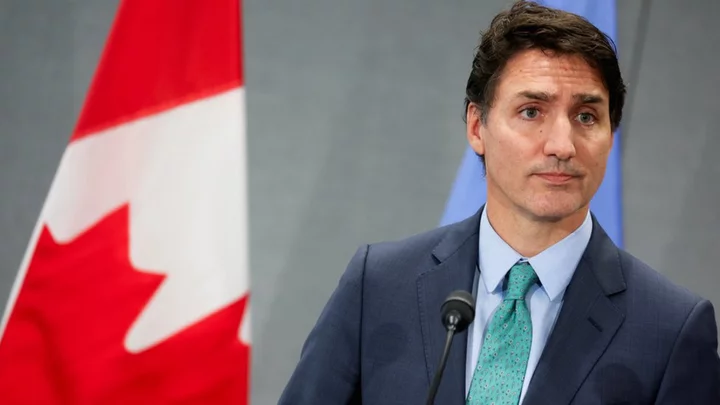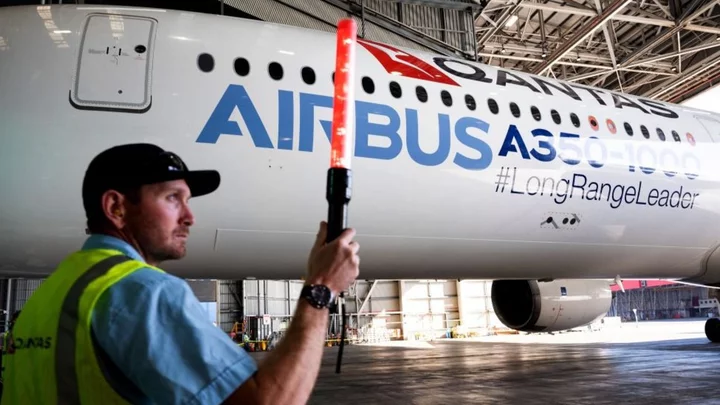The Yangtze River Delta has long been one of China’s richest regions, with fertile fishing grounds and rice paddies that have given way to a sprawling megalopolis that includes Shanghai. President Xi Jinping has been trying for years to turn the area into an even bigger economic powerhouse, hoping to create a Silicon Valley of the East.
The country’s economic slowdown, driven in part by tensions with the US and a slumping property market, is now starting to weigh on the project. Plans include an expanded high-speed rail network and a $2.6 billion artificial canal town meant to symbolize its eco-friendly ambitions. While few would dispute that the region remains a key economic driver, even Xi’s goal of creating a more efficiently-run economic bloc and high-tech arcadia hasn’t been spared the impact of the recent uncertainties.
“As the world splits into blocks, we don’t know to what extent trade would be curtailed,” said Shanghai-based independent economist Andy Xie. “International trade drives wealth creation here.”
The setback is particularly obvious in Lingang, a free-trade zone in the southeastern tip of Shanghai and a key part of the Yangtze Delta project. The government has offered low taxes and eased restrictions on cross-border trade in an attempt to turn the area into a high-end manufacturing and technology hub with the R&D centers and regional headquarters of multi-national companies. Today, it's struggling to attract foreign capital and talent.
It was hoped that Tesla Inc., which opened its new Gigafactory there in 2019, would be the first of many big-name industrial players in Lingang. But few have followed, and the biggest investors there today are mostly domestic names such as the state-controlled Semiconductor Manufacturing International Corp and electric vehicle battery maker Contemporary Amperex Technology Co. Ltd. If the US EV giant, now the target of a European Union anti-subsidy investigation, is found to have benefited from Chinese subsidies, countermeasures could deal a blow to the company and Lingang’s ambitions.
US companies looking to diversify supply chains since the pandemic have accelerated their shift out of China after Washington took steps to curb the country’s access to cutting-edge technology. Apple Inc., half of whose top suppliers own facilities in the Yangtze Delta, is one of many companies trying to reduce their exposure to China. Foxconn Technology Group and other key suppliers have also relocated some of their industrial chains.
One measure of new foreign investment in China, direct investment liabilities, fell to $4.9 billion in the April-June quarter, down 87% from the same period last year and the lowest since 1998.
The impact of so-called decoupling is already being felt, said Zhang Zhongwei, deputy head of the Shanghai Municipal Development and Reform Commission. He is also a vice director of the executive committee of the Yangtze integration project's pilot zone, which is about 60 kilometers (around 37 miles) to the west of downtown Shanghai.
“The feeling has definitely been obvious. Some enterprises, due to concerns about potential US sanctions, will likely be considering packing up and leaving, albeit unwillingly,” he told Bloomberg in an August interview to discuss the project’s progress and challenges.
A recent poll by the American Chamber of Commerce in Shanghai found that US companies in China are feeling the gloomiest in decades about doing business in the country, with nearly a fifth of respondents considering moving some of their operations elsewhere over the next few years. While officials are moving closer to arranging a meeting between President Joe Biden and Xi next month to stabilize ties, sources say nothing is yet decided as the two nations continue to trade jabs over issues such as export controls and Taiwan.
Signaling a lack of investor confidence in the future of the country’s tech industry, a gauge tracking the top 50 companies listed on Shanghai’s Nasdaq-style stock exchange — a crucial part of Xi's strategy to drive indigenous innovation and attract private capital to the technology sector — is hovering around record lows.
Competing, Not Cooperating
Another key part of the Yangtze Delta project is more abstract but possibly more consequential: improving cooperation and integration among the region’s provinces: Jiangsu, Zhejiang and Anhui, as well as Shanghai. The provinces have been locked in fierce competition for years, seeking to outdo each other in gross domestic product by promoting businesses within their boundaries. This, officials and economists say, has led to inefficient spending and is partly to blame for the repeated boom-and-bust cycles in industries like solar panel manufacturing.
Unveiled by Xi in 2018, the plan aims to integrate the economic development of the provinces, which together account for a quarter of China's $16 trillion economy. The government hopes that more efficient investment and free trade among the jurisdictions will bolster the area’s economy. It also wants provinces to stop favoring local suppliers in government procurement and projects, and instead choose what’s best for the broader bloc. In the long run, Xi wants to replicate such integration in other parts of the country.
However, local governments aren’t in a collaborative mindset, with falling land sales and business activity dealing a blow to their finances. Instead of boosting coordination, many have tried harder to lure businesses from neighboring provinces with sweeteners such as tax rebates and cheap real estate, according to official research reports and state media.
The Economic Daily, overseen by China’s cabinet, ran a front-page report in August warning bureaucrats against pursuing the kind of “vanity projects” that previously saddled local economies with heavy debt. The report noted industrial parks being built by authorities trying to lure emerging industries and projects.
Local governments are trying to take the lead in the semiconductor sector in particular, according to a recent research report by the Center for Yangtze River Delta and Economic Belt Research, an official think tank under the Shanghai Academy of Social Sciences.
“Each province, city, or even district and county is fighting on its own. There is a lack of coordination and they have wasted large amounts of valuable resources through duplicate construction,” it said.
Officials in charge of the integration project recently hired Boston Consulting Group to find ways of encouraging provinces to cooperate, said Zhang, the municipal official, while adding that there’s been some positive change, including around environmental protection.
Funding Pressure
Local governments are also grappling with funding pressures after hefty spending on pandemic controls. This has raised concerns about another centerpiece of the Yangtze project: broadening the area’s transportation network including expressways, high-speed rail and airports. Officials expect such infrastructure, along with energy pipelines and power grids, to require investments totaling tens of billions, if not hundreds of billions, in dollars. China is encouraging local governments to set up joint funds for this.
Jiangsu and Zhejiang were among the biggest provincial spenders on Covid controls in 2022, forking out a combined 85.8 billion yuan ($11.7 billion). Although they are still among the country’s wealthiest provinces and have managed to refinance debt, there are signs of strain. Jiangsu has had a particularly high number of local government financing vehicles — entities created after the 2008 global financial crisis to build everything from roads to sewage facilities — missing payment deadlines on commercial bills.
Yet Zhang shrugged off concerns that this would slow the Yangtze Delta’s infrastructure push, including a $13 billion, 170-kilometer high-speed rail project designed to shorten commuting times and slated for completion in 2028.
He says the Yangtze Delta project is still making progress, and that its purpose isn’t just about bolstering production in the area. A key goal is to offer a blueprint for the broader Chinese economy as it tries to shift away from a capital and energy-intensive growth model to one that’s more sustainable.
Part of that means moving up the industrial value chain beyond its low-cost advantage to avoid the so-called middle-income trap. With the Yangtze Delta, Xi wants to show that China can embrace what he calls “high-quality development” that’s not just about industrial growth — which is why the canal town is so important.
The 35.8-square-kilometer village will feature clusters of low-rise courtyard-style buildings with black tiles and white plaster walls, an architectural style once common in the region and still preserved in some ancient canal towns dotting the area. It will straddle the borders of Jiangsu, Zhejiang and Shanghai, and is due to be financed by those provinces along with proceeds raised from the capital market.
The village’s buildings, currently under construction, are expected to house offices, hotels, conference venues and retail spaces, and will be surrounded by winding waterways and wetlands, according to a miniature-scale model shown at the pilot zone.
Zhang said authorities hope the village, officially named Water Town Parlor and due to be fully completed by 2035, will act as a model for China's future development in which growth can coexist with cultural and environmental preservation. “Like Central Park in Manhattan,” he said.
--With assistance from Jin Wu.









